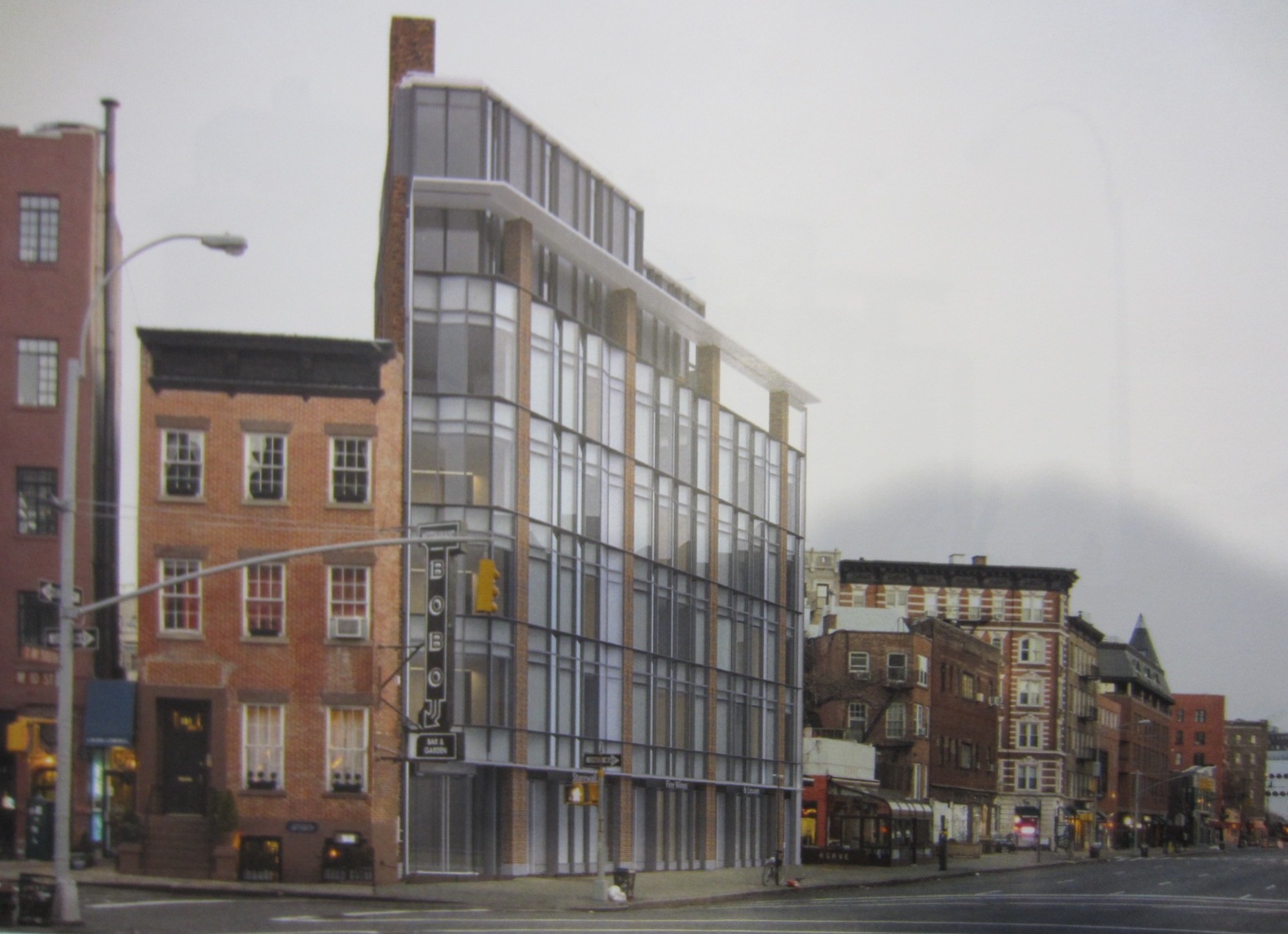
New rendering of 130 Seventh Avenue South in Greenwich Village, Manhattan. Image Credit: BKSK Architects.
Architecture firm BKSK replaced Gruzen Samton on a proposal for new seven-story structure where one-story building now stands. On January 21, 2014, the Landmarks Preservation Commission held a hearing for a proposed seven-story development on a triangular site at 130 Seventh Avenue South in the Greenwich Village Historic District, where a 1937 one-story building now stands. Landmarks previously held a hearing on the site’s development in July 2013. At a later public meeting, commissioners advised that the proposal required significant rethinking before it could be approved, but also determined that the existing one-story, heavily altered structure did not contribute substantially to the historic district and could be demolished.
At the January hearing, Jane Gol, president of Continental Ventures Realty, who is developing the site in partnership with the Keystone Group, said they were returning to Landmarks with a completely new plan for the site. The new proposal was designed by BKSK Architects. In response to comments by the commissioners and community members, the new plan would set back the seventh story, move the building’s massing towards the corner of 10th Street, and lower the height of the bulkhead by 12 feet.
BKSK’s Harry Kendall and George Schieferdecker presented the proposal. Kendall noted that his team had benefited from commissioner comments and critiques of the prior plan, and characterized the project as a “wonderful opportunity” for “urban regeneration.” Kendall stated that the existing building creates a gap in the Avenue streetwall and does not possess historic or architectural significance. He also noted that the Avenue was home to buildings of different eras and of a variety of scales.
Kendall said the proposal sought to reflect the site’s complex history “in a very modern idiom.” Before the extension of Seventh Avenue through Greenwich Village, the site had hosted the four party walls of adjoining rowhouses, which they used as a “metaphorical jumping-off point.” The building would be faced with a metal and glass curtain wall, with four chamfered brick piers memorializing the walls that once stood on the site. A metal “wrapper” would frame the front façade above the first floor, with cornice above the first and sixth floors. The metal courses on the facade are intended to recall the historic fire escapes of the district.
The 14,000 sq.ft., six-story-plus-penthouse structure will be mostly residential, with commercial use at the ground floor. The building would have three types of “folded, faceted” glass on its façade: transparent, translucent, and opaque. Much of the masonry secondary facades would be visible from public thoroughfares. The building would come to a point at the southern edge of the lot, which Schieferdecker referred to as a “prow,” where the main entranceway would be. As opposed to the 2013 proposal, the plan would leave open space at the rear of the lot.
A representative read joint statement from Council Member Corey Johnson, State Senator Brad Hoylman, and Assembly Member Deborah Glick, opposing the proposed development. The elected officials criticized the proposal for its “poor contextual design,” and said it would be detrimental to the historic district and its view corridors. Gregory Dietrich, consultant to the Compact for Urban Site Preservation, argued that the existing building possessed significance as an example of “vernacular Moderne style” architecture, and the proposal was of an “overwhelming scale.” Restaurateur Carlos Suarez, of the nearby Bobo, said the proposed building was out-of-scale and “egregiously out-of-character” with its surroundings, and would provide no public benefit. Herman Lowenhar, President of the Charles Street Synagogue, called the proposed building “a glass monstrosity.” The Greenwich Village Society for Historic Preservation’s Amanda Davis said the project was oversized and did not in any manner reflect the character of the Village. Numerous area residents also testified in opposition.
Speakers in favor of the proposal argued that the existing building detracted from the neighborhood, and the site’s redevelopment would benefit the community. Area resident Adam Pokornicky said the building currently at the site was “by no means charming,” and another speaker said it was “an eyesore and a blight.” Another resident said the new building would add character to the neighborhood.
Landmarks Chair Robert B. Tierney stated that Manhattan Community Board 2 recommended denial of the project as proposed, finding it too tall, and strongly objecting to the penthouse.
Commissioner Michael Goldblum found the proposal’s scale appropriate, but determined that the design would be improved by lessening its vertical emphasis, and reducing the amount of spandrel glass. He also criticized the design of the penthouse and its relationship to the building below. Commissioner Fred Bland again found the proposed demolition appropriate, but that proposed structure, though a “very smart building,” was too high and required a higher proportion of masonry. Commissioner Michael Devonshire stated that the proposal should be reduced by at least one story. Commissioner Libby Ryan recommended that it be lowered two floors, but also praised the use of materials as exciting and appropriate.
Chair Tierney closed the hearing without a vote, asking the applicants to return to Landmarks at a later date with a revised design.
LPC: 130 Seventh Avenue South, Manhattan (15-2143) (Jan. 21, 2014) (Architect: BKSK Architects).
By: Jesse Denno (Jesse is a full-time staff writer at the Center for NYC Law).

